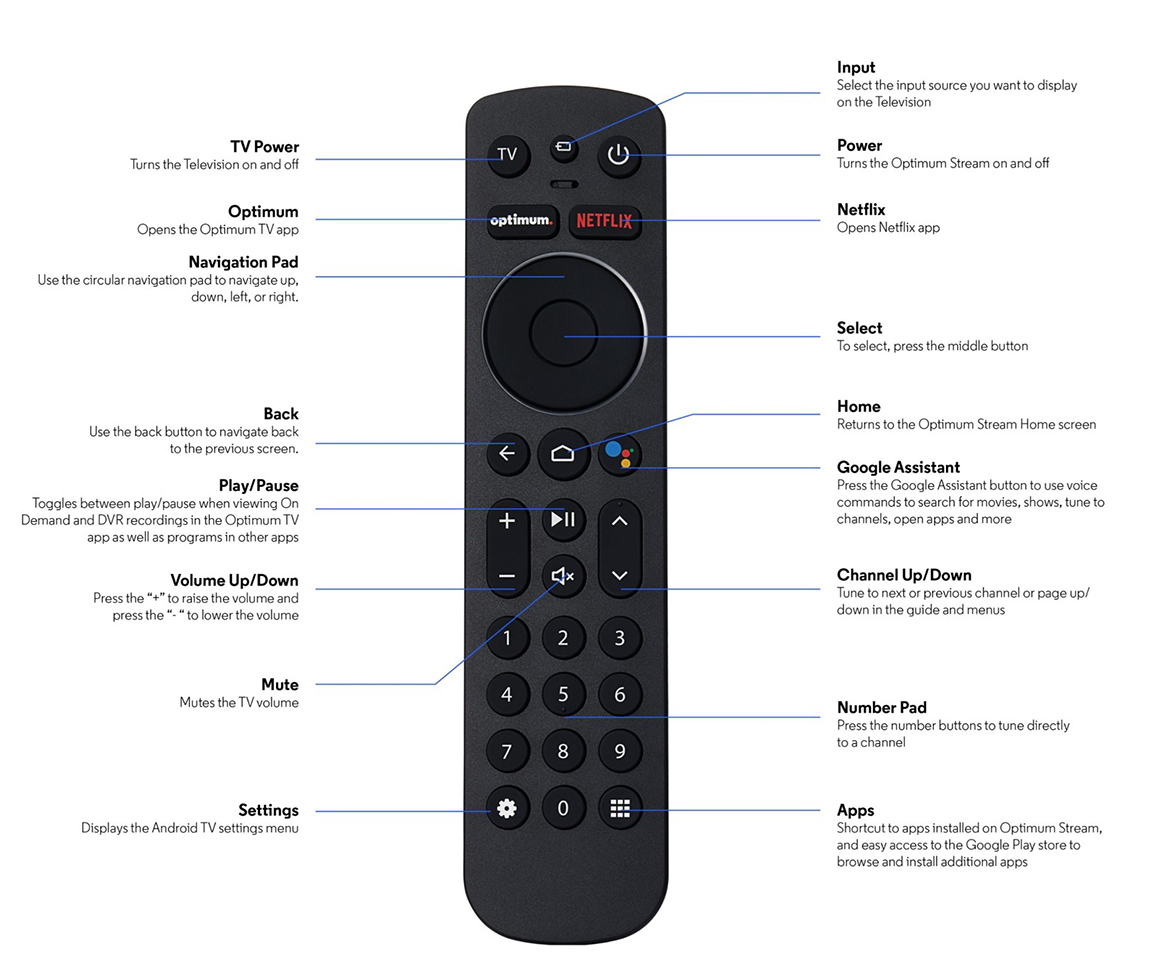If your Optimum remote is blinking, it may indicate low battery or signal interference. Troubleshoot by replacing batteries and checking for obstructions or nearby electronics.
Optimum remote blinking can be a frustrating issue that disrupts your TV viewing experience. When the remote’s light starts blinking, it signifies a problem that needs attention. Possible causes include low battery power, signal interference, or a faulty remote. By understanding the reasons behind the blinking light and following some simple troubleshooting steps, you can quickly resolve the issue and get back to enjoying your favorite shows hassle-free.
We will discuss common reasons for Optimum remote blinking, along with practical solutions to help you fix the problem promptly.
The Power Of Optimum Remote Blinking
The power of optimum remote blinking lies in its ability to revolutionize the way we interact with technology. By harnessing the potential of this cutting-edge innovation, users can experience a seamless and efficient control over their devices. Unlocking the secrets of this technology, understanding how it works, and reaping the numerous benefits it offers can truly enhance the user experience.
Unlocking The Secrets
Optimum remote blinking is based on an advanced technology that allows users to control their electronic devices through intuitive and effortless gestures. By simply blinking in a specific pattern, users can navigate through menus, adjust settings, and execute commands with unprecedented ease.
How It Works
The technology behind optimum remote blinking utilizes a combination of infrared sensors and advanced software algorithms to detect and interpret the user’s blinking patterns. This allows for precise and accurate control, enhancing user convenience and accessibility.
The Benefits
- Enhanced Accessibility: Optimum remote blinking provides an intuitive and hands-free way to interact with devices, making it especially beneficial for individuals with mobility limitations.
- Effortless Control: With the power of optimum remote blinking, users can effortlessly navigate through menus, interact with applications, and control various functions of their devices with simple blinking gestures.
- Improved User Experience: By eliminating the need for physical controllers or touch-based inputs, optimum remote blinking streamlines the user experience, offering a more fluid and natural interaction with technology.

Credit: satellitesale.net
Understanding Remote Blinking
Understanding Remote Blinking
In the world of remote controls, the phenomenon of remote blinking plays a crucial role in communication between the device and its user. Let’s delve into the depths of Remote Blinking to understand its significance.
What Is Remote Blinking?
Remote blinking is the visual signal that a remote control emits to indicate the successful transmission of a command to the corresponding device. It is an essential feedback mechanism that reassures the user of the interaction’s success.
History Of Remote Blinking
The history of remote blinking dates back to the early days of remote control technology when engineers realized the need for a visible confirmation of command execution. Since then, remote blinking has evolved as an integral part of user experience.
Remote Blinking Techniques
Unlock optimal remote blinking techniques for improved focus and reduced eye strain. Enhance productivity and well-being with simple yet effective practices. Master the art of remote blinking for better screen time and eye health.
Basic Remote Blinking
simplicity of mastering basic remote blinking techniques at your fingertips.
Advanced Remote Blinking
advanced techniques for seamless control.
Tips And Tricks
tipstricks to enhance your remote blinking experience.
Remote Blinking Techniques:
Remote blinking involves basicadvanced techniques. Whether you are a beginner or a seasoned pro, mastering these methods adds convenience to your daily routine.
Basic Remote Blinking
simple gestures to activate basic remote blinking functions effortlessly.
Advanced Remote Blinking
advanced remote blinking techniques for greater control and efficiency.
Tips And Tricks
tipstricks to optimize your remote blinking experience.
Remote Blinking is an art that anyone can master with the right techniques. From basic to advanced methods, these tips and tricks will enhance your remote blinking capabilities.

Credit: www.optimum.net
The Science Behind Remote Blinking
Remote blinking is the phenomenon where the individual blinks excessively or involuntarily while using the remote control, and it has piqued the interest of researchers from various fields. Understanding the science behind remote blinking involves delving into the neurological insights and the psychological effects that contribute to this curious behavior.
Neurological Insights
Neurological research has shed light on the intricate mechanisms that govern remote blinking. It has been found that the repetitive and automatic nature of pressing buttons on a remote control can trigger hyperactivity in the visual and motor areas of the brain. This heightened neural activity can lead to an increase in the frequency of blinking as a reflexive response to the visual stimuli and the motor actions associated with remote usage. Moreover, studies have shown that prolonged use of electronic devices, including remote controls, can impact the neural pathways responsible for eye movement, further affecting blinking patterns.
Psychological Effects
The psychological aspects of remote blinking are equally intriguing. Engaging in activities that demand focused attention, such as operating a remote control, can induce cognitive overload, leading to subconscious stress and anxiety. This mental tension often manifests as an increase in the rate of blinking as the brain attempts to regulate and alleviate the heightened cognitive load. Additionally, the repetitive nature of using a remote control can induce a state of trance-like concentration, wherein blinking becomes a secondary function as the primary focus remains on navigating the device, inadvertently causing a surge in blinking frequency.
Training Your Blinking Muscles
Improve your remote blinking by training your blinking muscles for optimum results. Practicing regular blinking exercises can help strengthen your eye muscles, promoting better eye health and reducing digital eye strain. With focused training, you can enhance your ability to blink more effectively while using remote devices.
Blinking. We do it so often throughout the day that we usually don’t give it a second thought. But did you know that blinking is not only essential for keeping our eyes moist and protected, but it also plays a crucial role in maintaining our overall eye health? Just like any other muscle in our body, our blinking muscles need regular training to stay strong and perform at their best. In this article, we will explore some exercises and tips to enhance your blinking and build your blinking endurance. So get ready to take your blinking to the next level and give your eyes the care they deserve.
Exercises For Blinking Enhancement
To improve your blinking, you can incorporate a few simple exercises into your daily routine. These exercises will help you strengthen the muscles responsible for blinking and enhance your overall eye coordination.
- Palming: Sit comfortably with your elbows on a table. Rub your palms together vigorously until they feel warm. Place your palms lightly over your closed eyes, ensuring no pressure is exerted on the eye sockets. Relax and take deep breaths. Visualize a soothing color or a serene scene. Do this for a few minutes, once daily.
- Focus-shifting: Hold your thumb approximately 10 inches away from your face. Focus your eyes on your thumb for a few seconds, then shift your focus to an object in the distance for another few seconds. Alternate between focusing on your thumb and a distant object, repeating this exercise 10 times.
- Blink intervals: Set a timer for every 20 minutes if you spend extended periods in front of a screen. When the timer goes off, blink your eyes rapidly for 20 seconds. This exercise helps prevent eye strain and keeps your blinking muscles active.
Building Blinking Endurance
As with any muscle training, building endurance for your blinking muscles takes time and consistency. Here are a few tips to help you gradually develop stronger and more resilient blinking muscles:
- Blink consciously and fully: Take a moment to be mindful of your blinking. Ensure that you blink fully, with both your upper and lower eyelids meeting, when you feel your eyes becoming dry or fatigued.
- Limit screen time: Prolonged screen time can cause dryness and strain on your eyes, leading to weakened blinking muscles. Take regular breaks and follow the 20-20-20 rule: every 20 minutes, look at an object 20 feet away for 20 seconds.
- Stay hydrated: Drinking an adequate amount of water throughout the day can help keep your eyes moisturized, reducing the need for excessive blinking. Aim for at least eight glasses of water per day.
- Reduce eye irritants: Avoid exposure to smoke, dust, and other irritants that can cause your eyes to become dry and itchy. Use protective eyewear when necessary.
Remember, just like any exercise routine, consistency is key. Practice these exercises regularly and incorporate healthy habits into your daily life to improve your blinking strength and endurance. Start today and give your eyes the care and attention they deserve.
Improving Concentration With Remote Blinking
Are you struggling to stay focused and concentrate on your tasks? If so, you’re not alone. Many people find it challenging to maintain their concentration in today’s fast-paced world. But what if there was a simple yet effective technique that could help you enhance your focus and improve your productivity? Introducing remote blinking – a powerful method that can significantly increase your ability to concentrate. In this article, we’ll explore the various techniques and benefits of remote blinking, and how you can incorporate it into your daily routine to achieve greater concentration.
Blinking Techniques For Focus
Blinking is a natural process that we often take for granted. However, research has shown that consciously incorporating blinking techniques can have a positive impact on our ability to concentrate. By encouraging the act of blinking at regular intervals, we can refresh our eyes, improve blood flow, and prevent eye fatigue. Here are a few simple blinking techniques you can incorporate into your routine:
- Blink naturally every 10-15 seconds while working or studying
- Set reminders on your phone or computer to prompt you to blink
- Practice the 20-20-20 rule – every 20 minutes, look at an object 20 feet away for 20 seconds and blink
By consciously implementing these blinking techniques, you can train yourself to maintain better focus and reduce eye strain, ultimately improving your overall concentration.
Combining Blinking With Meditation
If you’re looking for an extra boost in concentration, combining blinking techniques with meditation can help you achieve incredible results. Meditation is a practice that promotes mindfulness and a calm state of mind, making it easier to concentrate. Here’s how you can incorporate blinking into your meditation sessions:
- Find a quiet and comfortable space where you won’t be disturbed
- Assume a relaxed posture and close your eyes
- Take a few deep breaths to center yourself
- As you meditate, focus on your breath and let your thoughts come and go
- Consciously blink every few breaths, maintaining a steady rhythm
The combination of blinking and meditation allows you to achieve a deep state of concentration and better control over your thoughts and emotions. It can help you clear distractions and stay focused on the present moment, enhancing your overall productivity and performance.
Enhancing Productivity Through Remote Blinking
Enhancing productivity through remote blinking is a powerful tool that can help individuals stay focused and energized throughout the workday. By incorporating strategic blink breaks and minimizing distractions, remote workers can boost their efficiency and well-being, leading to enhanced performance and job satisfaction. In this article, we will explore the benefits of utilizing remote blinking techniques to optimize productivity and achieve a healthier work-life balance.
Maximizing Blink Breaks
Taking regular blink breaks is crucial for maintaining optimal eye health and preventing digital eye strain, especially for individuals who spend extended hours in front of computer screens. By incorporating short, intentional blink breaks into their remote work routine, workers can refresh their eyes and mitigate the negative effects of prolonged screen time. Implementing a schedule for blink breaks can help employees remain productive and focused, leading to improved overall work performance.
Using Blinking To Minimize Distractions
Intentional blinking can also be utilized as a technique to minimize distractions during remote work. By consciously blinking at regular intervals, individuals can train themselves to refocus their attention and avoid succumbing to external interruptions. This simple yet effective approach allows remote workers to maintain concentration and stay on task, leading to increased productivity and efficiency.
The Role Of Remote Blinking In Stress Reduction
Remote blinking plays a crucial role in reducing stress levels, promoting optimum relaxation. By incorporating regular blinking exercises into your remote work routine, you can effectively alleviate stress and enhance overall well-being.
The Role of Remote Blinking in Stress Reduction
The simple act of blinking can play a crucial role in reducing stress levels. Remote blinking, in particular, has been found to be an effective technique for promoting relaxation and combating stress.
Blinking For Relaxation
Regular blinking while using a remote control can help to relax the eye muscles and alleviate tension. Practice mindful blinking to promote calmness and focus during daily activities.
Reducing Eye Strain With Remote Blinking
Engaging in remote blinking exercises can prevent eye strain and alleviate discomfort associated with prolonged screen time. Integrate Blink Breaks into your routine to keep your eyes refreshed and stress-free.
Credit: volume-not-working-on-optimum-remote.fliegende-augen.de
Frequently Asked Questions
What Is Optimum Remote Blinking Used For?
Optimum Remote Blinking is used to control various electronic devices such as televisions, DVD players, and cable boxes with just a single remote.
How To Set Up Optimum Remote Blinking?
To set up Optimum Remote Blinking, follow these steps: 1. Turn on the device you want to program. 2. Press and hold the device button on the remote. 3. Enter the code for your device. 4. Release the device button.
5. Test the remote to ensure it is working properly.
Can I Program Multiple Devices With Optimum Remote Blinking?
Yes, you can program multiple devices with Optimum Remote Blinking. Simply follow the same setup process for each device you want to control.
What If My Device’s Code Is Not Listed In The Optimum Remote Blinking Manual?
If your device’s code is not listed in the Optimum Remote Blinking manual, you can try using the code search feature. This allows the remote to scan through all the available codes until it finds the right one for your device.
Conclusion
Mastering the art of remote blinking can significantly enhance productivity and reduce eye strain. By incorporating the 20-20-20 rule and adjusting display settings, users can optimize their remote working experience. Remember to take regular breaks and utilize eye protection measures to promote overall well-being and comfort.
